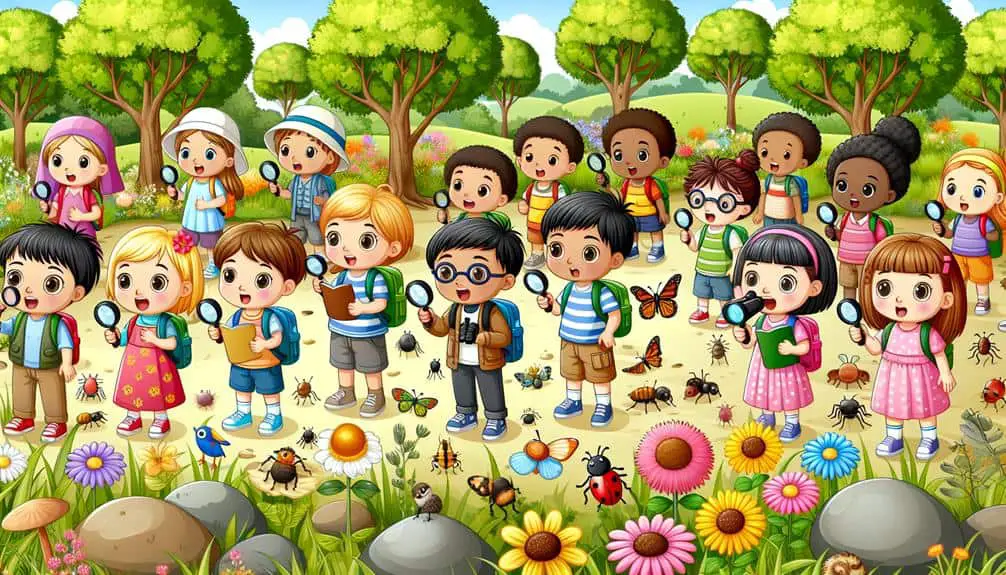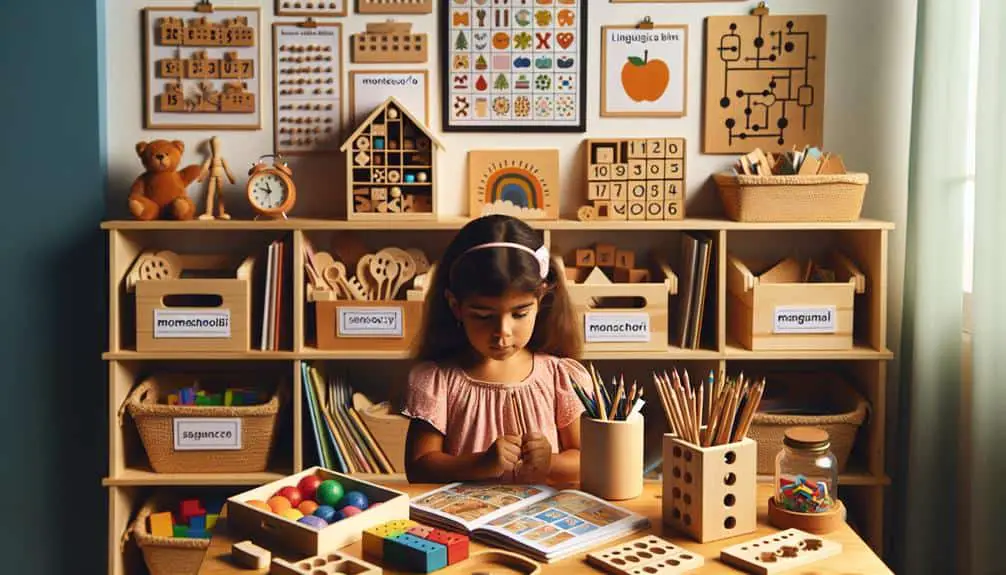Begin on a thrilling journey of hands-on discovery and wonder with these sensational science activities, specially designed for your preschooler's homeschool adventure! Plunge into taste test adventures, explore textures in blindfolded fun, and hunt for bugs with magnifying glass magic. Then, whip up kitchen chemistry wonders with baking soda volcanoes and fizzing eruptions. Don't forget to gaze at the sky, feel the wind, and track raindrops during weather watching adventures. Uncover the magic of plant life with seed germination and photosynthesis investigations. Ready for more excitement? Get ready for animal habitat explorations and space exploration activities!
Key Points
- Conduct taste test adventures to ignite curiosity and explore senses.
- Go on nature walks for leaf identification, bug hunts, and rock collecting.
- Engage in kitchen chemistry fun with baking soda reactions and vinegar volcanoes.
- Immerse in weather watching by observing the sky, wind, and rain.
- Explore plant life through seed germination, photosynthesis, and hands-on activities.
Sensory Science Experiments
Get ready to immerse yourself in a world of wonder with sensory science experiments that will ignite your preschooler's curiosity and engage their senses like never before! Let's kick off the excitement with a taste test adventure. Gather different foods with various flavors like sweet, salty, sour, and bitter.
Blindfold your little scientist and let them guess the tastes. It's a fun way to explore their sense of taste and discover new flavors together!
Next up, let's plunge into texture exploration. Collect items with different textures such as rough, smooth, bumpy, and soft. Encourage your child to feel each object and describe how it feels. Maybe they'll find a fuzzy toy, a hard rock, or a squishy ball.
This hands-on activity won't only enhance their tactile senses but also boost their descriptive language skills.
With taste tests and texture explorations, your preschooler will initiate a sensory journey full of surprises and learning opportunities. It's time to engage those senses and make science come alive in your homeschooling adventures!
Nature Walk Discoveries
Begin a nature walk adventure and reveal a world of exciting discoveries with your preschooler! Take a stroll outside, and let the exploration begin. Engage in leaf identification by collecting different leaves and matching them to the trees they came from. Encourage your little one to observe closely, touch gently, and smell the leaves to experience nature up close.
Embark on a bug hunt, searching under rocks and in bushes for tiny creatures. Use a magnifying glass to get a closer look at these fascinating insects. Encourage curiosity and ask questions like, 'What do you think this bug eats?' or 'How does it move?'
Rock collecting can also be a fun activity during your nature walk. Help your child find interesting rocks of different shapes, sizes, and colors. Talk about how rocks feel, their weight, and where they might've come from.
Lastly, encourage bird watching by listening for bird calls and trying to spot different birds in the trees. Bring along a pair of binoculars for a closer look at these feathered friends. Enjoy the wonders of nature together!
Kitchen Chemistry Fun
Let's explore the exciting world of Kitchen Chemistry Fun with your preschooler! Get ready for some bubbly excitement with baking soda reactions and food coloring mixtures. Mix a little of this, a little of that, and watch the colors swirl together in a mesmerizing dance of hues.
Now, how about immersing yourself in creating your very own vinegar volcanoes? Pour some vinegar into a container, add a dash of food coloring, and then sprinkle in baking soda. Get ready for some fizzy fun as the vinegar and baking soda react, creating a mini volcanic eruption right in your kitchen!
Your preschooler will be amazed at the magical transformations happening before their eyes. The combination of these simple kitchen ingredients can lead to big discoveries and plenty of giggles.
Weather Watching Adventures
Immerse your preschooler in the wonders of weather by stepping outside to observe the sky and feel the wind on your faces. Take a moment to lie down on a blanket and engage in some cloud gazing. Ask your little one what shapes they see in the clouds – maybe a fluffy bunny or a soaring airplane! Encourage them to describe the colors and how the clouds move across the sky.
When the rain comes, turn it into a fun activity by tracking the raindrops. Grab a waterproof notebook and draw each raindrop that falls. Count the drops together and see how many make it onto the page. Talk about how the rain helps plants grow and why it's important for the Earth.
Plant Life Investigations
Venture into the world of plants with your preschooler through exciting Plant Life Investigations! Let's begin by exploring seed germination. Planting seeds in soil and watching them sprout can be a magical experience for young learners. Encourage your child to observe how the seed first sends out a tiny root, then a shoot, reaching towards the sun.
Next, let's investigate the photosynthesis process. Explain to your little scientist how plants use sunlight, water, and carbon dioxide to make their food. You can set up a simple experiment by placing a plant in different light conditions and observing how it responds. This hands-on activity will help your child understand the importance of sunlight for plants to grow.
Animal Habitat Explorations
Hey there, little explorer! Ready to uncover the mysteries of animal habitats? Get ready to wander the wild with our animal friends and discover where they call home.
Let's set off on an adventure to learn all about animal homes and their fascinating habitats!
Animal Homes
Discover the fascinating world of animal homes through fun and interactive habitat explorations! Animals have unique ways of creating their shelters. Some animals like birds build nests using twigs, leaves, and other materials to keep their eggs safe and warm. You can mimic this by gathering materials in your backyard and creating your own cozy nest.
Other creatures, like rabbits and foxes, dig burrow homes underground. You can pretend to be a burrowing animal by digging tunnels in a sandbox or dirt area.
Don't forget to peek inside tree hollows, which provide shelter for animals like owls and squirrels. You can craft your own mini tree hollow using a cardboard tube and decorate it with leaves and twigs.
Habitat Discoveries
Curious how animals find their perfect homes in nature? Let's delve into habitat discoveries together!
When exploring animal habitats, you can engage in exciting adventures like a pond study or a forest exploration. Here are some fun ways to learn about where animals live:
- Create a Habitat Diorama: Use craft materials to make a mini-habitat for your favorite animal. Add details like trees, rocks, and ponds to bring the habitat to life.
- Animal Scavenger Hunt: Head outdoors and search for different animal habitats. Look for birds in trees, insects under rocks, or frogs near ponds.
- Build a Bug Hotel: Gather sticks, leaves, and other natural materials to create a cozy shelter for insects in your backyard.
- Nature Walk Observations: Take a stroll in the forest and observe the diverse habitats around you. Listen for birds in the trees or spot squirrels in their nests.
Exploring animal habitats through pond studies and forest explorations can spark curiosity and appreciation for the natural world around us!
Space Exploration Activities
Start on a thrilling journey through the cosmos with these hands-on space exploration activities for your preschool homeschooling adventures. Begin by igniting creativity with rocket building sessions. Use simple materials like paper rolls, cardboard, and paint to craft your spacecraft. Encourage your little astronaut to design their rocket with colorful patterns and stickers.
Next, explore the wonders of the night sky with stargazing nights. Lay out blankets, look up, and try to spot constellations like the Big Dipper. Discuss the vastness of space and spark curiosity about what lies beyond our planet.
For some astronaut training fun, create an obstacle course in your living room. Incorporate activities that mimic spacewalking, like jumping over 'craters' (pillows) and collecting 'moon rocks' (colored balls). This activity promotes gross motor skills while teaching about space exploration.
To enhance the experience, consider a virtual planetarium visit. Many institutions offer online shows that transport you through the galaxy. Sit back, relax, and enjoy a guided tour of the cosmos from the comfort of your home. Happy exploring!
Frequently Asked Questions
Can These Activities Be Adapted for Older Children?
Sure, for older children, these activities can be adapted easily! Get creative with sibling collaboration, modify complexity, and add in-depth explanations. Older kids will love the challenge and learning opportunities that come with these science activities.
How Can I Incorporate Art Into These Science Activities?
You can infuse art into science activities by creating colorful diagrams, painting nature scenes, or crafting models. Art integration sparks creativity and allows for unique interpretations. Encourage creative expression through drawing, sculpting, and collaging!
What Safety Precautions Should I Take for These Experiments?
Before diving into experiments, remember safety measures. Always provide supervision, especially with potential hazards. Use protective gear like goggles or gloves when needed. Make learning fun and safe!
Are There Any Recommended Science Kits for These Activities?
Looking for science kits? Online resources offer budget-friendly alternatives. Explore different options to enhance learning experiences. Consider kits that cater to preschoolers' curiosity and simplify complex concepts. Start the fun today!
How Can I Make These Activities More Interactive for My Child?
To make science activities more interactive for your child, try hands-on experiments and interactive demonstrations. Engage their senses through sensory exploration and take learning outside with outdoor exploration. Encourage curiosity and discovery in playful ways!



